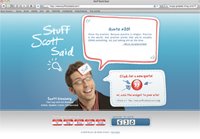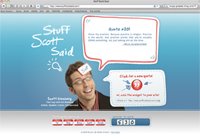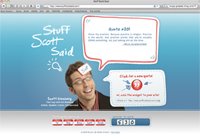 I was sitting on my mom’s couch when it happened.
I was sitting on my mom’s couch when it happened.
“Scott, did you notice what was missing from this article about you?” she asked.
“No. What?”
“Look closely. You’ll see it.”
And then it hit me like punch in the gut.
For the first time in my career – after eight years, ten books and five hundred interviews – this was the first article about me that wasn’t about my nametag.
In fact, the article didn’t even mention my nametag. The piece was about creativity, content management and entrepreneurial execution.
And as I sat back and soaked in the moment, my mom cemented the experience with single question:“How does it feel to be known for your brain – not just your badge?”
Pretty. Damn. Good.
LESSON LEARNED: When you learn to live larger than your labels, an entire symphony of advantages comes your way.
You expand your role repertoire.
You open yourself to becoming more.
You reengage with life’s possibilities.
You uncover new territory for expansion.
You invite new dimensions to your career.
You make profitable use of everything you are.
You crush the boundaries of your personal growth.
Today we’re going to explore strategies to help you live larger than your labels.
1. Know that you’re bigger than your past. Living larger than your labels means bowing to the door of next. Surrendering your case history. And accepting that whatever you created in the past – or whatever created you in the past – matters little beyond the fact that it brought you here.
After all, what happened to you isn’t who you are. Past is prologue. Past brought you here. Past made you who you are. And to align your thinking with this truth, try asking the following question:
If everything I’ve done up until now is just the beginning, what’s next?
When you start to explore a few answers, a new world of growth will opens up like a spring perennial. And you’ll forget all about those measly labels that once limited you.
Maybe Edwin McCain was right: Tell people to let you be who you’re becoming and stop seeing you as everything you’ve been. Will you view the past as a crutch or a catapult?
2. Cast a wider net. When I decided to redesign my blog this year, Tim at Out:Think asked me, “What’s going to be different this time around?”
To which I responded, “Well, I don’t want my blog to box me in. Not to one topic, not to one target market and not as one role. No labels, no limits.”
Two months later, the final product came out beautifully. And not only was the design striking, simple and professional, but Tim also added a minor accentuation that perfectly personified my limit-free objective. On the title bar it reads:
HELLO, my name is Blog! The Brain of Scott Ginsberg.
Yes, yes and yes. Exactly what I didn’t realize I needed. And the best part is: This positioning enables me, as an entrepreneur, to deliver value via infinite ways and via infinite channels. Even the ones I can’t think of yet.
Lesson learned: When you cast a wide net, the right customers will swim into it when they’re ready. How are you positioned in the minds of the people who matter most?
3. Make use of everything you are. Cali Lewis is the founder and host of GeekBeatTV, a widely popular podcast about technology, gadgets and important research projects.
During her keynote presentation at Blog World 2010, she discussed the concept of labels, and how they inhibit growth. And I swear I was the only person in the audience who heard it, but Cali had an inspiring throw-away line that I wrote down immediately:
“Don’t get me wrong: I love my website. But that’s not everything that I am.”
It takes a heroic dose of courage to admit that. To declare in front of thousands of people that your thing, your brainchild, your passion – that became widely successful because you worked your ass off eighteen hours a day for three years – is not all there is to who you are?
That’s how you live larger than you labels: When you realize that it’s okay to be known for more than one thing. As the Tao De Ching said, “When you let go of what you have, you get what you need.” What aspects of yourself – that you absolutely love – do you have to let go of to become something better?
4. Trace your trajectory. Have you ever mapped out your entire career, year by year, on one sheet of paper? It’s a fascinating exercise: Some call it a lifeline, some call it a visual biography or some call it a career trajectory map.
Either way, I was curious about it, so I decided to give it a whirl over the summer. And to say that the results were revelatory would be an understatement. Here’s what happens:
First, you become inspired to live larger than your labels by investigating the labels you’ve already outgrown.
Second, by examining each of the progress points of your professional life, you gain greater perspective on where you’ve been, where you’ve come and who you’ve become in the process.
Finally, because the exercise it’s a form of visual self-reflection and cumulative self-confrontation, the trajectory map helps you creates a healthy distance from yourself.
Ultimately, the map reflects your truth in a new light. The kind of light that outshines the brightness of the former version of yourself. The kind of light that helps you cut yourself loose from the past and swing into the future. When was the last time you traced your professional trajectory?
5. Think of your label as a dry erase board. I’ve never walked off stage without reminding my audience: “If you don’t make a name for yourself, someone will make one for you.”
However, as I evolve as a human being, I’ve recently decided to make an addendum to that philosophy: “If you refuse to rewrite the labels you stick onto yourself, you rob the world of the opportunity to experience the best, highest version of that self.”
That’s the problem with labels: They imply immunity. And you assume you’re nailed to a certain cross forever. Fortunately, you don’t have to choke on your labels. In Self Matters, Dr. Phil explains:
“Acknowledge the existence of labels, challenge the ‘fit,’ confront the impact these labels have on your concept of self, and then identify the payoff those labels have in your life.”
He’s more than just a mustache. When was the last time you took a long, honest look at the labels you gave yourself?
6. Differentiate between identification and definition. The most powerful life lessons come unsolicited, unidentified and unexpected. Like the anonymous email I received five years ago that read,
“Dear Scott: Big fan. Love the nametag concept. Hope you keep it up. And just remember: What identifies you doesn’t define you.”
After reattaching my jaw, it occurred to me how right that person really was: Identification is about recognition; definition is about explanation. And you need to be honest with yourself about differentiating between the two.
Here’s how: First, there’s the thing that brings you to the table. That which identifies you. And usually, it’s some kind of shtick.
Second, there’s the thing that keeps you in the room. That which defines you. And usually, it’s some kind of substance.
Now, both things are essential – but each thing fulfills a very different function. Your challenge is to confront the two levels of value that you provide. Otherwise you’ll walk into a room assuming people care about your nametag, when what people crave is the committed heart behind it. Are you identifiable or definable?
REMEMBER: To live larger than your labels is to reengage with life’s possibilities.
Therefore, as much as it pains me to say this, maybe it’s time to rip that stupid nametag off your shirt and open yourself to becoming something more.
No labels, no limits.
LET ME ASK YA THIS…
Are you ready to live larger than your labels?
LET ME SUGGEST THIS…
For the list called, “11 Ways to Become Brilliant By Next Thursday,” send an email to me, and I’ll send you the list for free!
* * * *
Scott Ginsberg
That Guy with the Nametag
Author, Speaker, Entrepreneur, Mentor
[email protected]
 Who’s quoting YOU?
Who’s quoting YOU?
Check out Scott’s Online Quotation Database for a bite-sized education on branding success!

 “Is it your place to fix this?”
“Is it your place to fix this?” Who’s quoting YOU?
Who’s quoting YOU? For those of you human beings out there (and I think you know who you are) here’s a quick list of assumptions.
For those of you human beings out there (and I think you know who you are) here’s a quick list of assumptions.  Who’s quoting YOU?
Who’s quoting YOU? For those of you human beings out there (and I think you know who you are) here’s a quick list of assumptions.
For those of you human beings out there (and I think you know who you are) here’s a quick list of assumptions.  Who’s quoting YOU?
Who’s quoting YOU?